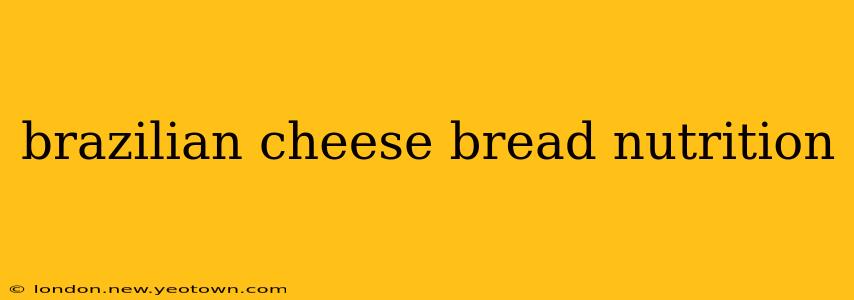Ah, pão de queijo! The irresistible, cheesy, fluffy bread that’s a staple of Brazilian cuisine. But beyond its delightful taste, what's the nutritional story behind this beloved treat? Let's explore the nutritional profile of pão de queijo and answer some common questions.
My name is Sofia, and I've spent years researching Brazilian cuisine and its impact on health and wellness. I'm passionate about sharing accurate information and dispelling myths surrounding popular foods. Let's delve into the world of pão de queijo nutrition together!
What are the main ingredients in Brazilian cheese bread?
The magic of pão de queijo lies in its simplicity. The primary ingredients are tapioca starch (also known as tapioca flour), cheese (typically Minas cheese, a firm, slightly salty cheese), eggs, oil, and sometimes milk or water. The tapioca starch is crucial; its unique properties give the bread its characteristic texture.
Is Brazilian cheese bread gluten-free?
Yes, pão de queijo is naturally gluten-free, making it a great option for those following a gluten-free diet. However, always double-check the ingredients list, especially if purchasing pre-made pão de queijo, to ensure that no gluten-containing ingredients have been added during processing. Cross-contamination is also something to keep in mind when preparing or purchasing gluten-free foods.
How many calories are in a Brazilian cheese bread?
The calorie count of a single pão de queijo can vary depending on its size and the specific recipe used. A typical medium-sized pão de queijo contains roughly 100-150 calories. However, this can increase significantly if the recipe uses a higher proportion of oil or cheese. Moderation is key, as with any treat.
Is Brazilian cheese bread healthy?
This is a complex question. While pão de queijo is gluten-free, it's not necessarily a "health food" in the strictest sense. It's relatively high in carbohydrates from the tapioca starch and also contains fat from the cheese and oil. However, it can be part of a balanced diet when consumed in moderation. The nutritional value depends significantly on the ingredients used and the portion size. Using healthier oils and leaner cheeses can help improve its nutritional profile.
What are the macronutrients in Brazilian cheese bread?
A typical pão de queijo provides a significant amount of carbohydrates primarily from the tapioca starch. It also contains a moderate amount of fat, largely from the cheese and added oil. The protein content is relatively low, mainly sourced from the cheese and eggs. The exact macronutrient breakdown varies depending on the recipe and size.
What are the vitamins and minerals in Brazilian cheese bread?
Pão de queijo offers a modest amount of certain vitamins and minerals, primarily derived from the cheese. This includes calcium, which is essential for bone health, and some B vitamins. However, it doesn’t serve as a primary source of these nutrients. A balanced diet will provide more substantial quantities.
Is Brazilian cheese bread good for weight loss?
Due to its calorie and carbohydrate content, pão de queijo is not ideal for weight loss diets. While it’s possible to incorporate it occasionally, it's essential to be mindful of portion sizes and overall caloric intake to maintain or lose weight.
Are there any variations of Brazilian cheese bread?
Yes! While traditional pão de queijo uses Minas cheese, variations exist with different cheeses like parmesan or cheddar. Some recipes also incorporate herbs or spices for added flavor. Experimentation is part of the fun!
In conclusion, while pão de queijo isn't a health food per se, it can certainly be enjoyed as part of a balanced diet. Its gluten-free nature and delicious taste make it a treat worth savoring in moderation. Remember to pay attention to portion sizes and ingredient choices to optimize its nutritional profile. Enjoy responsibly!

